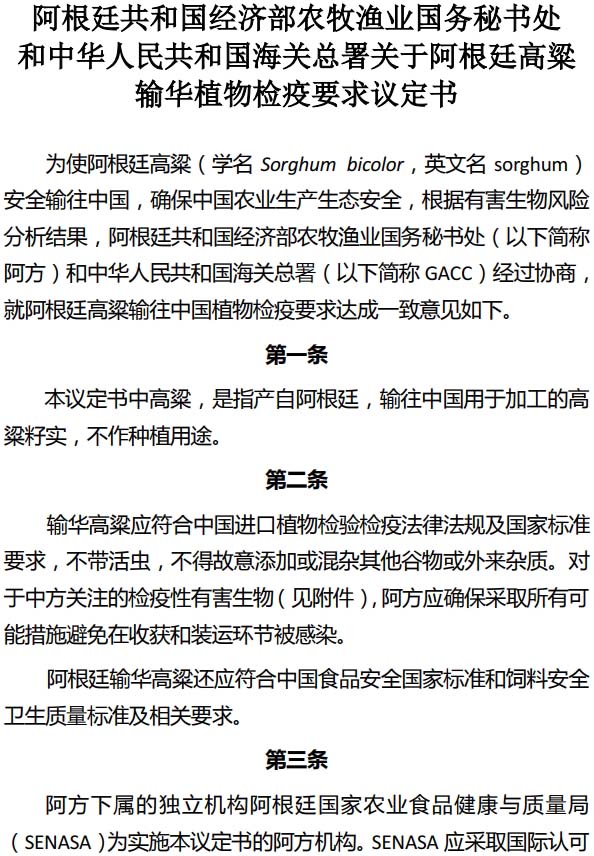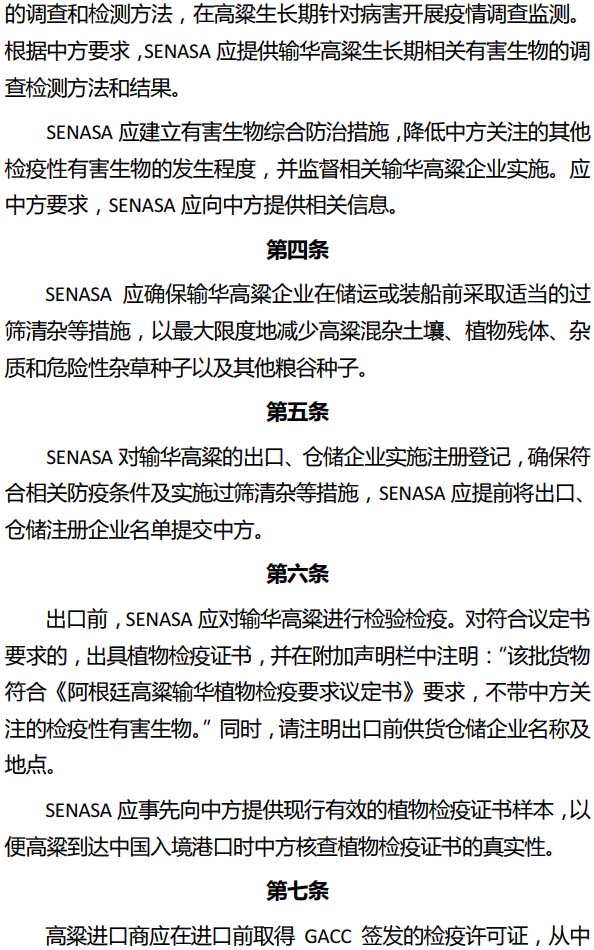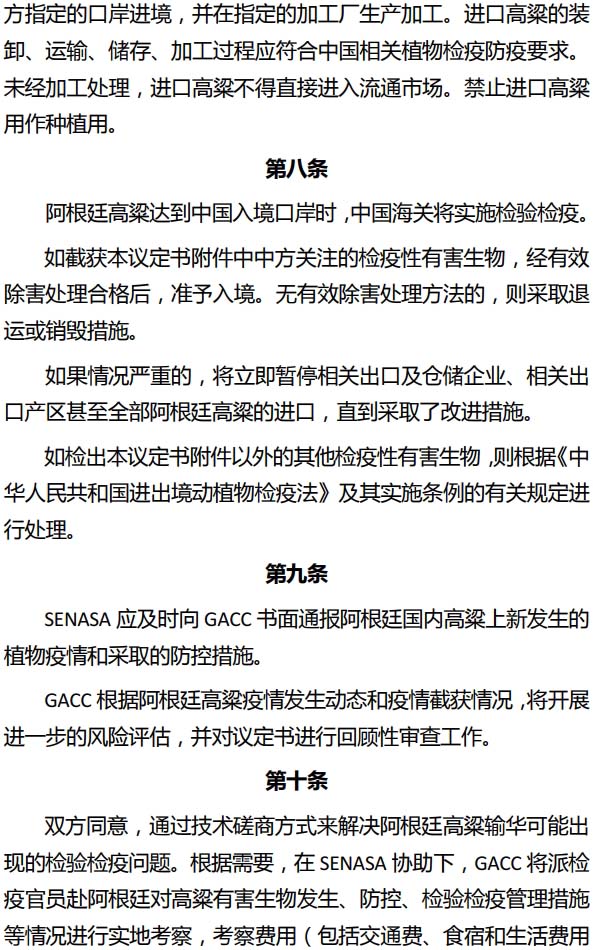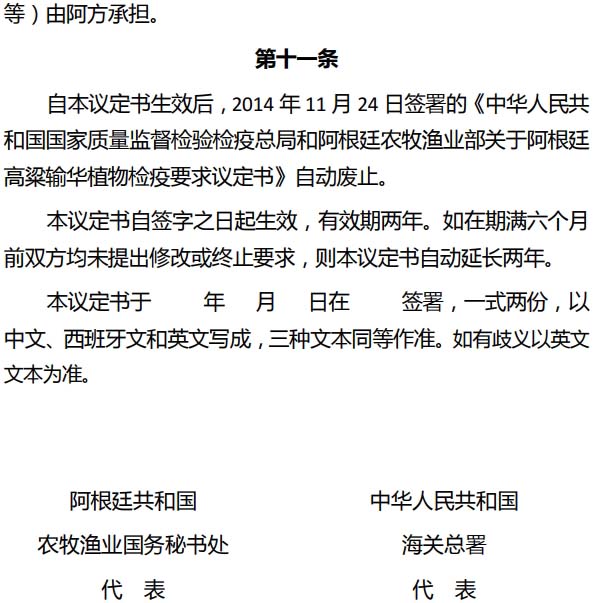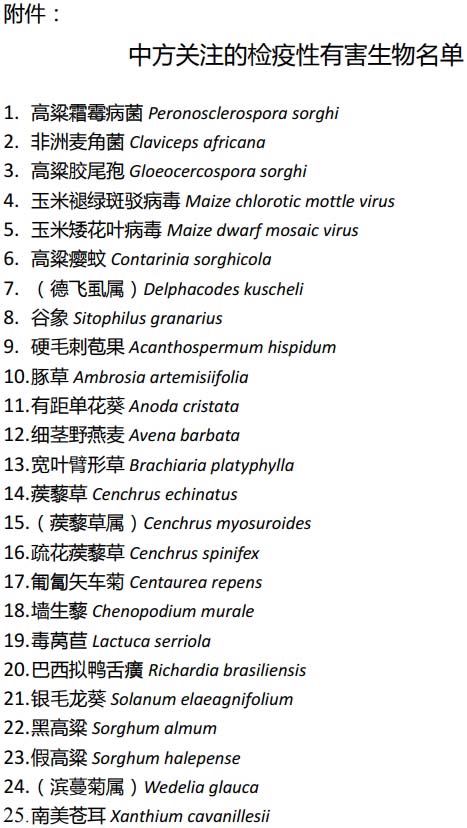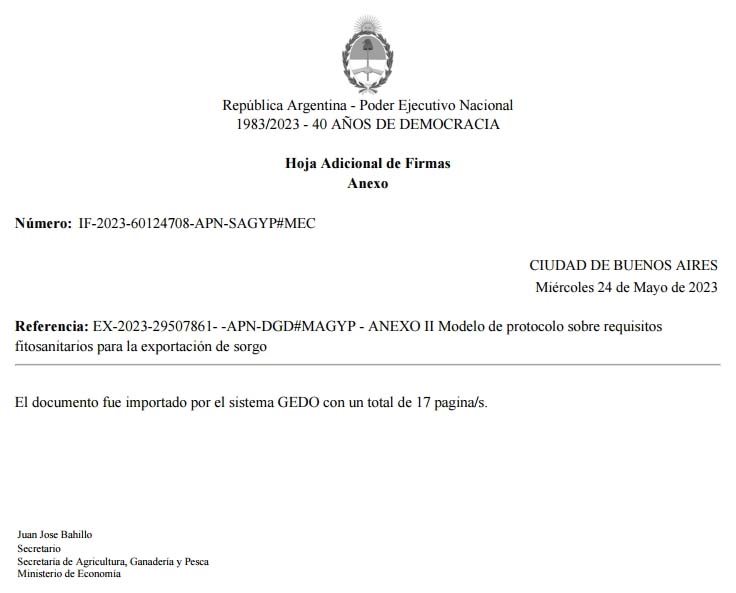MINISTERIO
DE ECONOMÍA
Resolución 699/2023
RESOL-2023-699-APN-MEC
Ciudad de Buenos Aires, 24/05/2023
Visto el Expediente EX-2023-29507861-APN-DGD#MAGYP, la Ley de
Ministerios N° 22.520 -t.o. 1992- y sus modificaciones, y el Decreto N°
480 de fecha 10 de agosto de 2022, y
CONSIDERANDO:
Que el Artículo 20 de la Ley de Ministerios -t.o. 1992- y sus
modificaciones, establece las competencias del MINISTERIO DE ECONOMÍA,
entre las cuales se encuentra la de promover la apertura y reapertura
de los mercados internacionales para el sector de la agricultura, la
ganadería y la pesca en materia de su competencia, participando en la
elaboración de estrategias para la solución de controversias, en todo
lo referido al acceso de estos productos en los mercados externos, en
el ámbito de su competencia.
Que, asimismo, el MINISTERIO DE ECONOMÍA entiende en la defensa fito y
zoosanitaria de fronteras, puertos, aeropuertos y en la fiscalización
de la importación de origen agropecuario, forestal y pesquero como así
también en el monitoreo de las negociaciones sanitarias y
fitosanitarias, junto con el SERVICIO NACIONAL DE SANIDAD Y CALIDAD
AGROALIMENTARIA (SENASA), organismo descentralizado en la órbita de la
SECRETARÍA DE AGRICULTURA GANDERÍA Y PESCA del citado Ministerio.
Que por el Decreto N° 480 de fecha 10 de agosto de 2022 se
establecieron los objetivos de la SECRETARÍA DE AGRICULTURA, GANADERÍA
Y PESCA del MINISTERIO DE ECONOMÍA, entre los cuales se encuentra,
proponer estrategias para la solución de controversias, en todo lo
referido al acceso de productos de los sectores agroalimentarios y
agroindustriales a los mercados externos, en coordinación con las áreas
con competencia en la materia.
Que con fecha 15 de febrero de 2012 y 24 de noviembre de 2014, el
entonces MINISTERIO DE AGRICULTURA, GANADERÍA Y PESCA suscribió con la
ADMINISTRACIÓN GENERAL DE SUPERVISIÓN DE CALIDAD, INSPECCIÓN Y
CUARENTENA de la REPÚBLICA POPULAR CHINA los protocolos de requisitos
fitosanitarios para la exportación de maíz y la exportación de sorgo,
respectivamente, desde la REPÚBLICA ARGENTINA a la REPÚBLICA POPULAR
CHINA (cf,. IF-2023-20401820-APN-DNRRII#MAGYP e
IF-2023-20404745-APN-DNRRII#MAGYP).
Que, luego de varios intercambios con la REPÚBLICA POPULAR CHINA se
acordaron nuevos protocolos para la exportación de maíz y sorgo al
haberse actualizado el “Listado de plagas Cuarentenarias de interés
para la República Popular China” de los Anexos I correspondientes a
ambos protocolos.
Que, en atención a los objetivos de la SECRETARÍA DE AGRICULTURA,
GANADERÍA Y PESCA del MINISTERIO DE ECONOMÍA, y por razones de
celeridad, eficiencia y eficacia en los procedimientos, resulta
necesario delegar la suscripción de los protocolos mencionados en el
titular de dicha secretaría.
Que el Servicio Jurídico Permanente del MINISTERIO DE ECONOMÍA ha
tomado la intervención que le compete.
Que la presente medida se dicta en uso de las facultades conferidas por
la Ley de Ministerios -t.o 1992- y sus modificaciones.
Por ello,
EL MINISTRO DE ECONOMÍA
RESUELVE:
ARTÍCULO 1°.- Apruébanse los modelos de “Protocolo de requisitos
fitosanitarios para la exportación de maíz desde Argentina a China
entre la Secretaría de Agricultura, Ganadería y Pesca del Ministerio de
Economía de la República Argentina y la Administración General de
Aduanas de la República Popular China” y de “Protocolo sobre requisitos
fitosanitarios para la exportación de sorgo desde la República
Argentina a la República Popular China entre la Secretaría de
Agricultura, Ganadería y Pesca del Ministerio de Economía de la
República Argentina y la Administración General de Aduanas de la
República Popular China” que como ANEXOS I y II
(IF-2023-60124933-APN-SAGYP#MEC e IF-2023-60124708-APN-SAGYP#MEC,
respectivamente), forman parte integrante de la presente medida.
ARTÍCULO 2°.- Delégase en el Secretario de Agricultura, Ganadería y
Pesca del MINISTERIO DE ECONOMÍA la facultad de suscribir los
protocolos cuyos modelos se aprueban por el Artículo 1° de esta
resolución.
ARTÍCULO 3°.- Comuníquese, publíquese, dese a la DIRECCIÓN NACIONAL DEL
REGISTRO OFICIAL y archívese.
Sergio Tomás Massa
NOTA: El/los Anexo/s que integra/n este(a) Resolución se publican en la
edición web del BORA -www.boletinoficial.gob.ar-
e. 30/05/2023 N° 39436/23 v. 30/05/2023
(Nota
Infoleg:
Los anexos referenciados en la presente norma han sido extraídos de la
edición web de Boletín Oficial)
ANEXO I
PROTOCOLO
DE REQUISITOS FITOSANITARIOS PARA LA EXPORTACIÓN DE MAÍZ DESDE
ARGENTINAA CHINA ENTRE LA SECRETARÍA DE AGRICULTURA, GANADERÍAY PESCA
DEL MINISTERIO DE ECONOMÍA DE LA REPÚBLICAARGENTINAY LAADMINISTRACIÓN
GENERAL DE ADUANAS DE LA REPÚBLICAPOPULAR CHINA
Con el objeto de exportar maíz (nombre científico:
Zea mays L., en adelante denominado
"maíz") de manera segura desde la REPÚBLICA ARGENTINA a la REPÚBLICA
POPULAR DE CHINA y garantizar la seguridad de la agricultura y la
zoología en China, sobre la base de los resultados del análisis de
riesgo de plagas (ARP), la SECRETARÍA DE AGRICULTURA, GANADERÍA Y PESCA
del MINISTERIO DE ECONOMÍA de la REPÚBLICA ARGENTINA (en adelante
denominada SAGyP) y la Administración General de Aduanas de la
REPÚBLICA POPULAR CHINA (en adelante denominada GACC) han intercambiado
sus puntos de vista y alcanzado los siguientes acuerdos en relación con
los requisitos fitosanitarios para el maíz argentino.
Artículo
1
El maíz en el presente Protocolo se refiere a granos de maíz producidos
en la REPÚBLICA ARGENTINA y exportados a la REPÚBLICA POPULAR CHINA
para procesamiento y no para siembra.
Artículo
2
El SERVICIO NACIONAL DE SANIDAD Y CALIDAD AGROALIMENTARIA, organismo
descentralizado de la SAGyP (en adelante denominado SENASA) será el
organismo argentino de ejecución del presente Protocolo.
Artículo
3
El maíz que se exporte a la REPÚBLICA POPULAR CHINA cumplirá con las
leyes en materia fitosanitaria, regulaciones sobre importación y normas
nacionales de la REPÚBLICA POPULAR CHINA correspondientes y estará
libre de insectos vivos y plagas cuarentenarias que preocupan a la
REPÚBLICA POPULAR CHINA (listadas en el Anexo 1) y no estará mezclado o
contaminado deliberadamente con otros granos o material extraño.
Otras normas y requisitos de la REPÚBLICA POPULAR CHINA, tales como
aquellos relacionados con la inocuidad y sanidad de alimentos y
piensos, también se aplicarán al maíz argentino.
Artículo
4
SENASA realizará investigaciones y análisis durante la época de siembra
del maíz, utilizando métodos de vigilancia y análisis para
enfermedades. SENASA presentará a GACC un reporte de monitoreo de estas
plagas, incluyendo los métodos y los resultados, en las áreas de
producción durante el corriente año, así como también otra información
requerida por GACC.
SENASA establecerá medidas para un sistema de manejo integrado de
plagas (MIP), a fin de reducir la ocurrencia de las plagas que
preocupan a la REPÚBLICA POPULAR CHINA y supervisará su aplicación por
parte de las empresas privadas que tengan por objeto exportar granos de
maíz a China. A pedido de GACC, SENASA le proporcionará la información
pertinente.
Artículo
5
SENASA controlará que las empresas que exporten granos de maíz a la
REPÚBLICA POPULAR CHINA lleven a cabo actividades de limpieza, tales
como zarandeo, en el proceso de almacenamiento y transporte del maíz o
previamente a su carga para reducir significativamente la tierra, los
restos de plantas, las impurezas, las semillas de hierbas peligrosas,
sorgo u otras semillas de grano.
Artículo
6
SENASA registrará a los exportadores y elevadores que exporten maíz a
la REPÚBLICA POPULAR CHINA para asegurar que cumplan con las
condiciones cuarentenarias y normas de calidad chinas pertinentes.
SENASA informará a GACC con anticipación la lista de los exportadores y
elevadores registrados.
Artículo
7
SENASA deberá realizar una inspección cuarentenaria del maíz antes de
su exportación a la REPÚBLICA POPULAR CHINA. Para los envíos que
cumplan con los requisitos especificados en el presente Protocolo,
SENASA emitirá un Certificado Fitasanitario que incluirá una
declaración adicional: "El presente envío cumple con los requisitos
descriptos en el Protocolo de Requisitos Fitosanitarios para la
Exportación de Maíz desde Argentina a China y está libre de las plagas
cuarentenarias que preocupan a China".
SENASA proporcionará con anticipación un modelo del Certificado
Fitosanitario actualmente vigente en la REPÚBLICA ARGENTINA para que
GACC pueda determinar fácilmente su autenticidad cuando el envío
ingrese a los puertos de la REPÚBLICA POPULAR CHINA.
Artículo
8
Los importadores chinos deberán obtener un permiso de importación
expedido por GACC previo a la importación. El maíz argentino deberá ser
importado por puertos designados por GACC y ser procesado en plantas
designadas por dicha Administración. El transporte, la manipulación, el
almacenamiento y el procesamiento del maíz importado deberán cumplir
con el requisito chino de prevención y cuarentena vegetal. El maíz
argentino no podrá ser distribuido en forma directa antes de su
procesamiento y está prohibida su siembra.
Artículo
9
Cuando el maíz argentino arribe a los puertos de entrada chinos, las
Aduanas de China realizarán la inspección y cuarentena.
Si se encontrara alguna de las plagas cuarentenarias que figuran en el
Anexo 1 del presente Protocolo, el envío solo será autorizado a
ingresar luego de un tratamiento efectivo. En caso de que el
tratamiento no resultare efectivo, el envío deberá ser devuelto o
destruido. Los costos pertinentes serán abonados por el exportador. Si
el problema resultare lo suficientemente grave, tanto el exportador
argentino como el elevador, e incluso todo el maíz argentino, serán
suspendidos en forma inmediata hasta tanto se tomen medidas correctivas.
Si se identificaran otras plagas cuarentenarias no categorizadas en el
Anexo 1 del presente Protocolo, el envío será tratado de acuerdo con
las disposiciones pertinentes de la
Ley
de Cuarentena Animal y Vegetal de Entrada y Salida de la República
Popular de China (Law of the People's Republic of China on the
Entry and Exit Animal and Plant Quarantine) y de las normas de
implementación de la misma.
Artículo
10
SENASA informará prontamente por escrito a GACC toda nueva ocurrencia
de plagas de maíz en el territorio de la REPÚBLICA ARGENTINA, como así
también las medidas adoptadas por SENASA.
GACC realizará una nueva evaluación de riesgo y revisará el presente
Protocolo basándose en la situación de ocurrencia de plagas y las
interceptaciones de maíz argentino. Si los virus
Maize dwarf Mosaicy Wheat streakMosaic son
encontrados, las plagas anteriormente indicadas serán incluidas en el
listado de plagas de interés cuarentenario de la República Popular
China (listado en Anexo)
Artículo
11
Ambas Partes se comprometen a solucionar los posibles problemas de
inspección y cuarentena mediante consultas técnicas relacionadas con
las importaciones de maíz argentino a la REPÚBLICA POPULAR CHINA. En
caso de resultar necesario, GACC, en cooperación con SENASA, enviará
funcionarios cuarentenarios a la REPÚBLICA ARGENTINA para revisar el
manejo del control de plagas, la gestión de inspecciones y cuarentenas,
etc. que realice SENASA; los gastos relacionados con la visita,
incluidos transporte, alojamiento y gastos de estadía, estarán a cargo
de la Parte exportadora.
Artículo
12
Desde la fecha que entre en vigencia el presente Protocolo, el
Protocolo de Requisitos Frtosanitarios para la Exportación de Maíz
desde Argentina a China entre la Administración General de Supervisión
de Calidad, Inspección y Cuarentena de la República Popular China y el
Ministerio de Agricultura, Ganadería y Pesca de la República Argentina,
firmado el 15 de febrero de 2012, quedará revocado.
El presente Protocolo entrará en vigencia a partir de la fecha de su
firma y permanecerá vigente por un período de DOS (2) años. En caso de
que ninguna de las Partes notifique su intención de enmendar o
rescindir el presente Protocolo por lo menos seis meses antes de su
fecha de vencimiento, el presente Protocolo será prorrogado
automáticamente por períodos sucesivos de DOS (2) años.
Firmado en a
los días
del mes
de
de 2022, en los idiomas chino, español e inglés, siendo todos los
textos igualmente auténticos. En caso de divergencias, prevalecerá el
texto en idioma inglés.
En
representación de la
Secretaría de Agricultura,
Ganadería y Pesca de la
REPÚBLICA ARGENTINA
|
En
representación de la
Administración General de
Aduanas de la REPÚBLICA
POPULAR CHINA |
ANEXO 1:
Lista
de plagas cuarentenarias que preocupan a China
1.
Peronosclerospora sorghi
2.
Maize chlorotic mottle virus
3.
Liposcelis bostrychophila
4.
Sitophilus granarius
5.
Listronotus bonariensis
6.
Acanthospermum hispidum
7
Ambrosia artemisiifolia
8.
Anoda cristata
9.
Avena sterilis
10.
Brachiaria platyphylla
11.
Cenchrus spinifex
12.
Centaurea repens
13.
Lactuca serriola
14.
Rapistrum rugosum
15.
Sorghum halepense
PROTOCOL
OF PHYTOSANITARY REQUIREMENTS FOR THE EXPORT OF MAIZE FROMARGENTINA TO
CHINA BETWEEN THE SECRETARY OF AGRICULTURE, LIVESTOCKAND FISHERIES OF
THE MINISTRY OF ECONOMY OF THE REPUBLIC OF ARGENTINAAND THE GENERAL
ADMINISTRATION OF CUSTOMS OF THE PEOPLE’S REPUBLIC OF CHINA
In order to safely export maize (scientific name:
Zea mays L., hereinafter called
“maize”) from the Republic of Argentina into the People's Republic of
China, and ensure the security of agriculture and zoology in China,
based on the results of the pest risk analysis (PRA), the Secretary of
Agriculture, Livestock and Fisheries of the Ministry of Economy of the
Republic of Argentina (hereinafter referred to as SAGyP) and the
General Administration of Customs of the People's Republic of China
(hereinafter referred to as GACC) have exchanged views and reached
agreements on the phytosanitary requirements of Argentine maize as
follows.
Article
1
The maize in this Protocol is maize grain which is produced in
Argentina and exported to China for processing and nor for sowing.
Article
2
The National Service for Agri-food Health and Quality, a decentralize
body of SAGyP (hereinafter referred to as SENASA) shall be the
Argentina executive body of this Protocol.
Article
3
The maize being exported to China shall comply with the relevant
phytosanitary laws, regulations on import and national standards of
China and be free of live insects and quarantine pests concerned by
China (listed in the Annex l) and not be commingled or contaminated
with other grain or extraneous materials deliberately.
Other Chinese standards and requirements such as those regarding food
and feed safety and quality, may also apply to Argentine maize.
Article
4
SENASA shall carry out investigation and test during the growing season
of maize using international approved surveillance and test methods for
disease. SENASA shall submit to GACC a report of surveillance of these
pests, including the methods and the results, in the production areas
during the current year, as well as other information requested by GACC.
SENASA shall establish integrated pest management system (IPM) measures
to minimize the pests’ occurrence, which are concerned by China, and
supervise their application by private enterprises that intend to
export maize grains to China. Upon any request by GACC, SENASA shall
provide GACC with the relevant information.
Article
5
SENASA shall control those enterprises that export maize grains to
China undertake cleaning activities, such as sifting, in the process of
maize storage and transportation, or prior to loading, to reduce
significantly the soil, plant debris, impurities, dangerous weed seeds,
sorghum or other grain seeds.
Article
6
SENASA shall register exporters and elevators exporting maize to China
to ensure that they meet the relevant Chinese quarantine conditions and
quality standards. SENASA shall notify in advance to GACC the list of
those registered exporters and elevators.
Article
7
SENASA should conduct a quarantine inspection of the maize prior to
export to China. For the consignment which meets requirements specified
in this Protocol, SENASA shall issue a Phytosanitary Certificate
including an additional declaration: “The consignment is in compliance
with requirements described in the Protocol of Phytosanitary
Requirements for the Export of Maize from Argentina to China and is
free from the quarantine pests concerned by China”.
SENASA shall provide the sample of the Phytosanitary Certificate
currently valid in the Republic of Argentina in advance in order for
GACC to determine easily their genuineness when consignment enters the
ports of the People's Republic of China.
Article
8
An Import Permit issued by GACC should be acquired by Chinese importers
prior to importation. Argentine maize should be imported at ports
designated by GACC and be processed at plants designated by GACC.
Transportation, handling, storage and processing of imported maize
should be in compliance with the Chinese plant quarantine and
preventive requirement. Argentine maize cannot be distributed directly
before processing, and sowing is prohibited.
Article
9
When Argentine maize arrives in Chinese entry ports, China Customs will
carry out inspection and quarantine.
If any quarantine pests in the Annex 1 of this Protocol is found, the
consignment will only be allowed to enter after effective treatment. In
case of no effective treatment, the consignment shall be returned or
destroyed. The relevant cost will be paid by the exporter. If the
problem is serious enough, the Argentine relevant exporter and
elevator, and even all Argentine maize, will be suspended immediately
until remedial actions have been taken.
If other quarantine pests not categorized in the Annex 1 of this
Protocol is identified, the consignment shall be treated in accordance
with the relevant provisions of the
Law
of the People's Republic of China on the Entry and Exit Animal and
Plant Quarantine and its regulations for implementation.
Article
10
SENASA shall inform GACC in writing of any newly occurrence of pests of
maize in the territory of The Republic of Argentina, and measures taken
by SENASA in a timely manner.
GACC will develop further risk assessment and review this Protocol
based on the situation of pest occurrence and interceptions from
Argentine maize. If
Maize dwarf
Mosaic virus and
Wheat streak
mosaic virus are found, the above pests will be listed in list
pests of quarantine concern to the People’s Republic of China (Listed
in the Annex).
Article
11
Both sides agree to solve possible inspection and quarantine issues
through technical consultation regarding Argentine maize imports into
China. If necessary, in cooperation with SENASA, GACC will send
quarantine officials to Argentina to review the pest control
management, inspection and quarantine management etc. by SENASA, the
expenses related to the visit, including transportation, accommodation
and living expenses, will be covered by export country side.
Article
12
As of the date of entry into force of this Protocol, The Protocol of
phytosanitary requirements for the export of maize from Argentina to
China between the General Administration of Quality Supervision,
Inspection and Quarantine of the People’s Republic of China and the
Ministry of Agriculture, Livestock and Fisheries of the Republic of
Argentina, signed on February 15, 2012, shall be repealed.
The Protocol will enter into force on the date of signature and will
remain valid for a period of two years. If neither side gives notice to
amend or terminate this Protocol at least six months prior to the
expiry date, this Protocol will be extended automatically for
successive periods of two years.
Singed in
on , 2022
each in Chinese, Spanish and English languages, all the texts being
equally authentic. In case of divergence, English text shall prevail.
For the
Secretary of Agriculture,
Livestock and Fisheries of the
Republic of Argentina
|
For the General Administration
of Customs of the People’s
Republic of China
|
ANNEX 1:
List
of Quarantine Pest Concerned by China
1.
Peronosclerospora sorghi
2.
Maize chlorotic mottle virus
3.
Liposcelis bostrychophila
4.
Sitophilus granarius
5.
Listronotus bonariensis
6.
Acanthospermum hispidum
7.
Ambrosia artemisiifolia
8.
Anoda cristata
9.
Avena sterilis
10.
Brachiaria platyphylla
11.
Cenchrus spinifex
12.
Centaurea repens
13.
Lactuca serriola
14.
Rapistrum rugosum
15.
Sorghum halepense
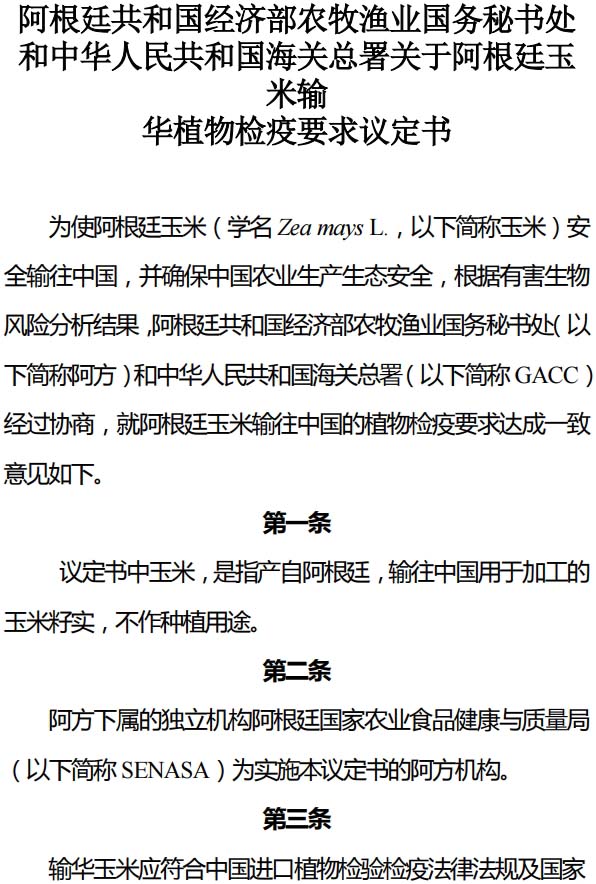
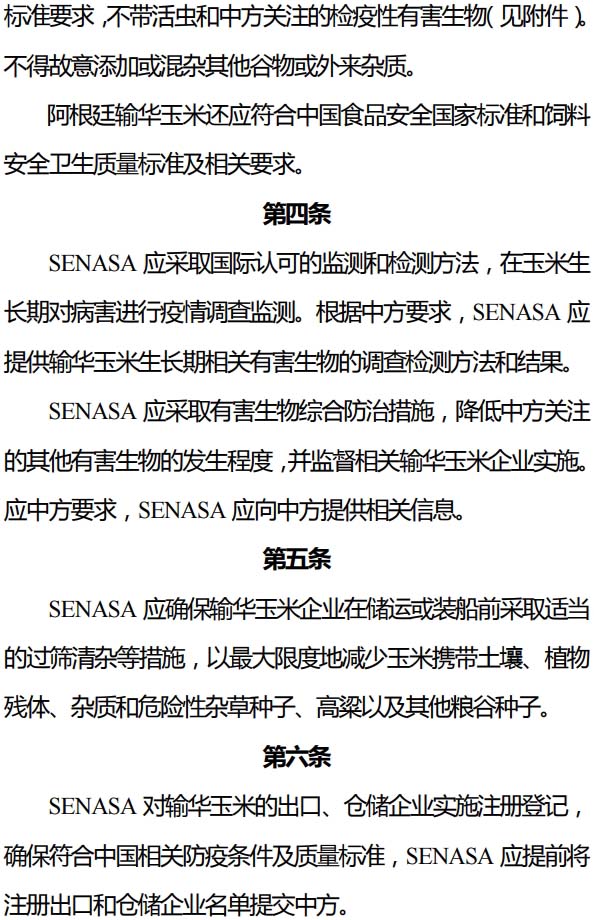
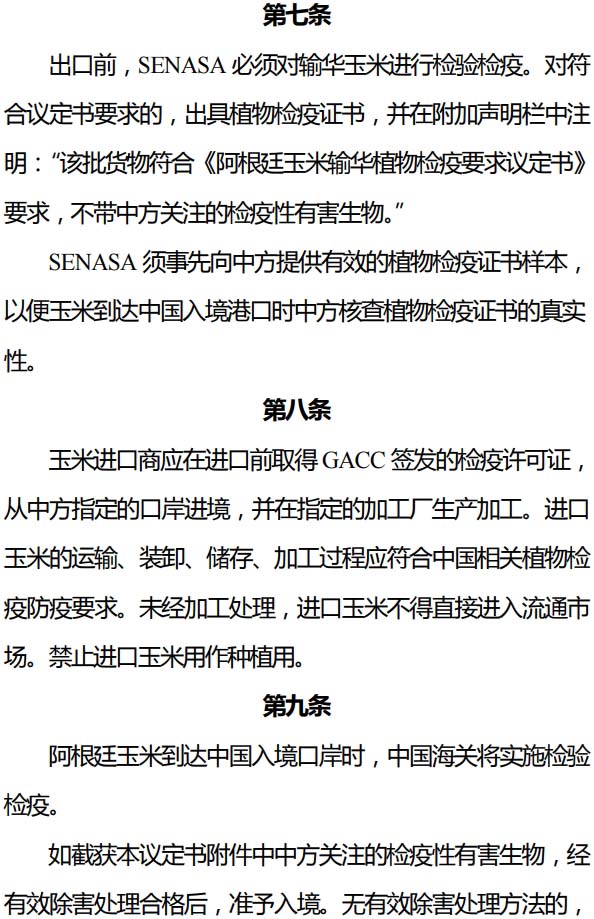
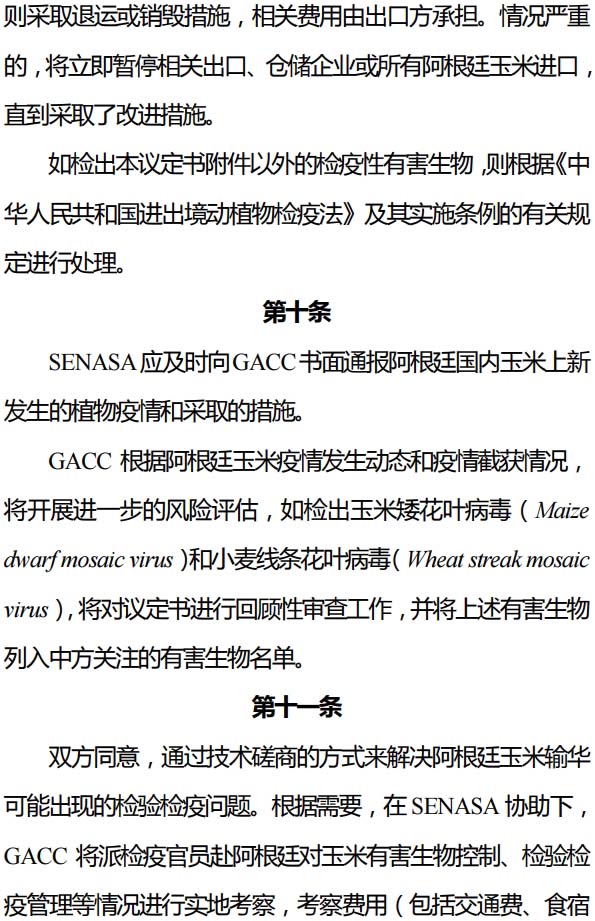
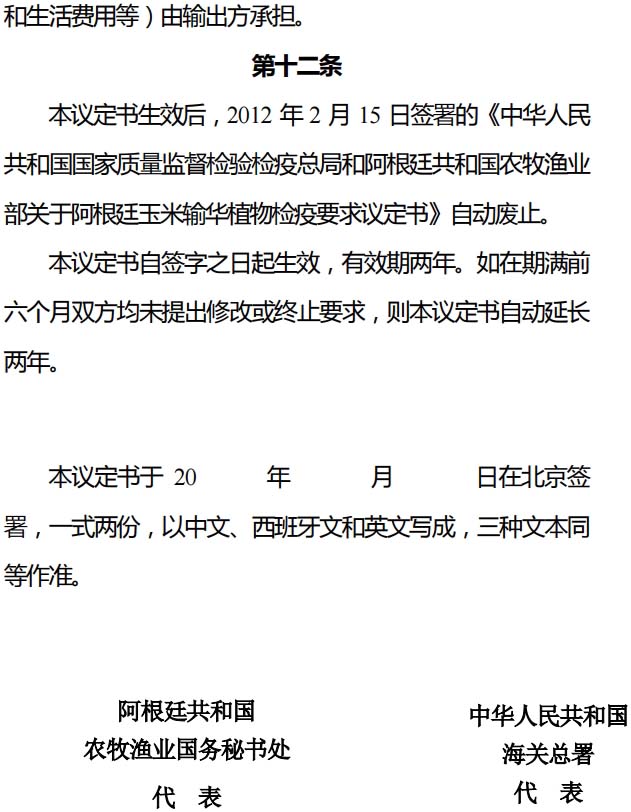
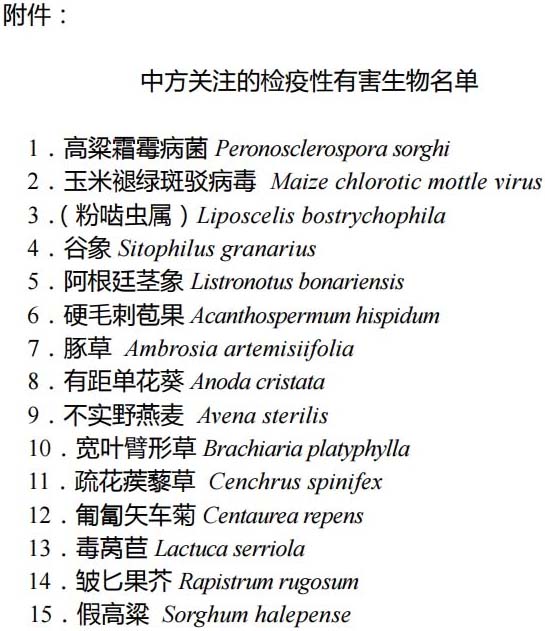
IF-2023-60124933-APN-SAGYP#MEC
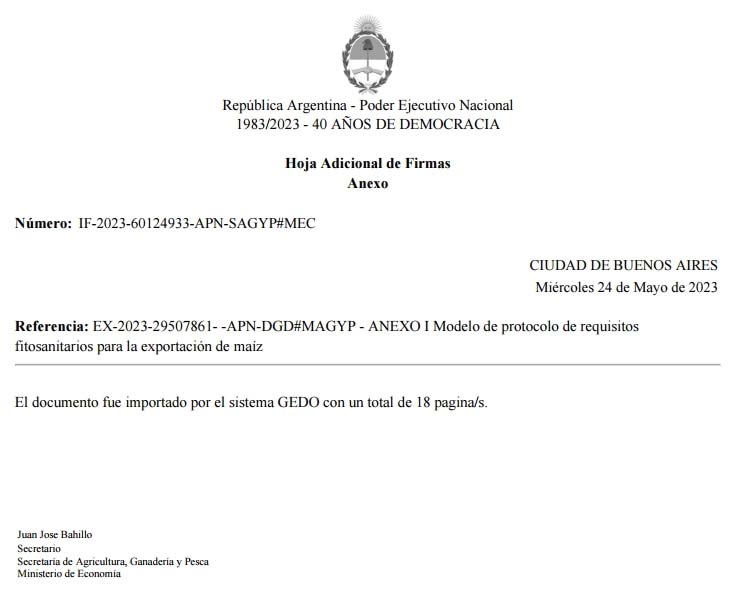
ANEXO
II
PROTOCOLO
SOBRE REQUISITOS FITOSANITARIOS PARA LA EXPORTACIÓN DE SORGO DESDE LA
REPÚBLICA ARGENTINA A LA REPÚBLICA POPULAR CHINA ENTRE LA SECRETARÍA DE
AGRICULTURA, GANADERÍA Y PESCA DEL MINISTERIO DE ECONOMIA DE LA
REPÚBLICA ARGENTINA Y LA ADMINISTRACIÓN GENERAL DE ADUANAS DE LA
REPÚBLICA POPULAR CHINA
Con el propósito de exportar sorgo (cuyo nombre científico es
Sorghum bicolor y su nombre común
“sorgo”) de manera segura desde la REPÚBLICA ARGENTINA a la REPÚBLICA
POPULAR CHINA y garantizar la seguridad de la agricultura y la ecología
en la REPÚBLICA POPULAR CHINA, sobre la base de los resultados del
análisis de riesgo de plagas (ARP), la SECRETARÍA DE AGRICULTURA,
GANADERÍA Y PESCA del MINISTERIO DE ECONOMÍA de la REPÚBLICA ARGENTINA
(en adelante SAGyP) y la Administración General de Aduanas de la
REPÚBLICA POPULAR CHINA (en adelante GACC) han intercambiado posiciones
y alcanzado los siguientes acuerdos sobre los requisitos fitosanitarios
para el sorgo argentino.
Artículo
1
Para el presente Protocolo, se entiende por sorgo al grano de sorgo que
es producido en la REPÚBLICA ARGENTINA y exportado a la REPÚBLICA
POPULAR CHINA para su procesamiento, no para siembra.
Artículo
2
El sorgo exportado a la REPÚBLICA POPULAR CHINA cumplirá con las normas
fitosanitarias, regulaciones de importación y normas nacionales de
relevancia de la REPÚBLICA POPULAR CHINA, estará libre de insectos
vivos y no estará mezclado o contaminado con otros granos o materias
extrañas que pudieran contener plagas cuarentenarias de manera
deliberada. Con respecto a las plagas cuarentenarias de interés para la
REPÚBLICA POPULAR CHINA (enumeradas en el Anexo), la REPÚBLICA
ARGENTINA realizará todos los esfuerzos posibles para cosechar y enviar
cargamentos libres de ellas. Otras normas y requisitos de la REPÚBLICA
POPULAR CHINA, tales como aquellos relacionados con la inocuidad y
sanidad de alimentos y piensos, también se aplicarán al sorgo argentino.
Artículo
3
El SERVICIO NACIONAL DE SANIDAD Y CALIDAD AGROALIMENTARIA, Organismo
descentralizado en la órbita de la SAGYP, en adelante SENASA, será el
Organismo argentino ejecutor del presente Protocolo. SENASA realizará
investigación y análisis durante la temporada de crecimiento del sorgo
utilizando métodos de análisis y vigilancia para enfermedades. SENASA
presentará a GACC un reporte de monitoreo de estas plagas, incluyendo
los métodos y resultados, en las áreas de producción durante el
corriente año, así como también otra información requerido por GACC.
SENASA establecerá un sistema de manejo integrado de plagas (MIP) que
provea medidas para minimizar casos con aparición en sorgo de otras
plagas cuarentenarias de interés para la REPÚBLICA POPULAR CHINA y
supervisar su aplicación por parte de las empresas pertinentes. A
petición de GACC, SENASA le suministrará la información pertinente.
Artículo
4
SENASA controlará que las empresas que exporten sorgo a la REPÚBLICA
POPULAR CHINA lleven a cabo actividades de limpieza, tales como
zarandeo, en el proceso de cosecha o previo al embarque, para eliminar
tierra, residuos vegetales, impurezas y semillas de malezas peligrosas,
como así también semillas de otros granos.
Artículo
5
SENASA deberá mantener un registro de exportadores y elevadores de
exportación de sorgo a la REPÚBLICA POPULAR CHINA para garantizar que
cumplan con las condiciones de cuarentena pertinentes y apliquen
medidas de limpieza como el zarandeo. SENASA deberá notificar con
antelación a GACC la lista de exportadores y elevadores registrados.
Artículo
6
SENASA deberá realizar las actividades de cuarentena e inspección de
sorgo antes de la exportación a la REPÚBLICA POPULAR CHINA. Para los
envíos que cumplan con los requisitos especificados en el presente
Protocolo, SENASA emitirá un Certificado Fitosanitario con la siguiente
declaración adicional: “El envío cumple con los requisitos establecidos
en el Protocolo sobre Requisitos Fitosanitarios para la Exportación de
Sorgo desde la REPÚBLICA ARGENTINA a la REPÚBLICA POPULAR CHINA y ha
sido inspeccionado con el fin de evitar la presencia de plagas
cuarentenarias de importancia para la REPÚBLICA POPULAR CHINA”.
Adicionalmente, deberán estar consignados el nombre y la dirección de
los exportadores y elevadores.
SENASA suministrará, por adelantado, el modelo de Certificado
Fitosanitario vigente en la REPÚBLICA ARGENTINA a fin de que GACC
determine fácilmente su autenticidad al momento en que el envío ingrese
en los puertos de la REPÚBLICA POPULAR CHINA.
Artículo
7
El Permiso de Importación expedido por GACC deberá ser adquirido por
los importadores chinos antes de la importación. EL sorgo debe ser
importado en los puertos designados por la GACC y procesado en las
plantas designadas por la GACC. La carga y descarga, transporte,
almacenamiento y procesamiento del sorgo importado debe realizarse en
cumplimiento del requisito de cuarentena y prevención de la REPÚBLICA
POPULAR CHINA. El sorgo importado no deberá ser distribuido
directamente antes de su procesamiento y su siembra está prohibida.
Artículo
8
Cuando el sorgo argentino arribe a los puertos de entrada de la
REPÚBLICA POPULAR CHINA, las Aduanas de China llevarán a cabo la
inspección y cuarentena.
Si se encuentra cualquier plaga cuarentenaria del Anexo del presente
Protocolo, se permitirá la entrada del envío luego de la aplicación de
un tratamiento efectivo. En caso de no haber tratamiento efectivo, el
envío será devuelto o destruido.
Si el problema es lo suficientemente serio, el sorgo importado del
exportador y elevador correspondiente, las áreas de producción
pertinentes o incluso todas las zonas de producción argentinas de sorgo
serán inmediatamente suspendidos para exportar a la REPÚBLICA POPULAR
CHINA, hasta que se tomen medidas correctivas.
Si se identificaran plagas cuarentenarias no consignadas en el Anexo
del presente Protocolo, el envío será tratado de acuerdo con las
disposiciones pertinentes de la Ley de la REPÚBLICA POPULAR DE CHINA
sobre la Cuarentena de Ingreso y Egreso de Animales, y Vegetales y sus
normas de aplicación.
Artículo
9
SENASA informará por escrito a GACC sobre la ocurrencia de nuevas
plagas en sorgo en el territorio argentino, y sobre las medidas de
control tomadas oportunamente por el SENASA.
El GACC realizará un nuevo análisis de riesgo y revisará el presente
Protocolo sobre la base de la ocurrencia de plagas e intercepciones de
sorgo de la REPÚBLICA ARGENTINA.
Artículo
10
Ambas Partes acuerdan resolver posibles inspecciones y cuestiones
cuarentenarias sobre la importación de sorgo de la REPÚBLICA ARGENTINA
a la REPÚBLICA POPULAR CHINA, a través de consultas técnicas.
De ser necesario, en cooperación con el SENASA, GACC enviará a la
REPÚBLICA ARGENTINA funcionarios de cuarentena para revisar la
ocurrencia de plagas y las medidas de control, la gestión de
inspecciones y cuarentenas, etcétera, que realice el SENASA. Los gastos
relativos a las visitas, incluyendo traslado, alojamiento y estadía,
serán cubiertos por la parte argentina.
Artículo
11
Desde la fecha que entre en vigencia el presente Protocolo, el
Protocolo de Requisitos Fitosanitarios para la Exportación de Sorgo
desde Argentina a China entre la Administración General de Supervisión
de Calidad, Inspección y Cuarentena de la República Popular China y el
Ministerio de Agricultura, Ganadería y Pesca de la República Argentina,
firmado el 24 de noviembre de 2014, quedará revocado.
El presente Protocolo entrará en vigencia en la fecha de su firma y
permanecerá vigente por un período de DOS (2) años. Si ninguna de las
Partes notifica su intención de enmendar o rescindir el presente
Protocolo al menos SEIS (6) meses antes de su fecha de vencimiento, el
presente Protocolo se prorrogará automáticamente por períodos sucesivos
de DOS (2) años.
Firmado en la ciudad
de
el
por duplicado, en idiomas chino, español e inglés siendo todos los
textos igualmente auténticos. En caso de controversia, prevalecerá el
texto en inglés.
En
representación de la
Secretaría de Agricultura,
Ganadería y Pesca de la
REPÚBLICA ARGENTINA |
En
Representación de la
Administración General de
Aduanas de la REPÚBLICA
POPULAR DE CHINA |
ANEXO
Listado de Plagas Cuarentenarias de
interés para la REPÚBLICA POPULAR CHINA
1.
Peronosclerospora sorghi
2.
Claviceps africana
3.
Gloeocercospora sorghi
4.
Maize chlorotic mottle virus
5.
Maize dwarf mosaic virus
6.
Contarinia sorghicola
7.
Delphacodes kuscheli
8.
Sitophilus granarius
9.
Acanthospermum hispidum
10.
Ambrosia artemisiifolia
11.
Anoda
cristata
12.
Avena barbata
13.
Brachiaria platyphylla
14.
Cenchrus echinatus
15.
Cenchrus myosuroides
16.
Cenchrus spinifex
17.
Centaurea repens
18.
Chenopodium murale
19.
Lactuca serriola.
20.
Richardia brasiliensis
21.
Solanum elaeagnifolium
22.
Sorghum almum
23.
Sorghum halepense
24.
Wedelia glauca
25.
Xanthium cavanillesii
PROTOCOL
OF PHYTOSANITARY REQUIREMENTS FOR THE EXPORT OF SORGHUM FROM ARGENTINA
TO CHINA BETWEEN THE SECRETARY OF AGRICULTURE, LIVESTOCK AND FISHERIES
OF THE MINISTRY OF ECONOMY OF THE ARGENTINE REPUBLIC AND THE GENERAL
ADMINISTRATION OF CUSTOMS OF THE PEOPLE’S REPUBLIC OF CHINA
In order to safely export sorghum (the scientific name is
Sorghum bicolor and the English
name is “sorghum”) from Argentina into China and to ensure the safety
of agriculture and ecology in China, based on the results of the pest
risk analysis (PRA), the Secretary of Agriculture, Livestock and
Fisheries of the Ministry of Economy of the Argentine Republic
(hereinafter referred to as SAGyP) and the General Administration of
Customs of the People's Republic of China (hereinafter referred to as
GACC) have exchanged views and reached agreements on the phytosanitary
requirements for sorghum from Argentina, as follows.
Article
1
The sorghum in this Protocol is sorghum grain which is produced in
Argentina and exported to China for processing, and not for sowing.
Article
2
The sorghum which is exported to China shall comply with the applicable
phytosanitary laws, regulations on import and national standards of
China, be free of live insects and not be deliberately commingled or
contaminated with other grain or extraneous materials which may contain
quarantine pests. Regarding quarantine pests concerned by China (listed
in Annex), Argentina shall conduct all possible efforts to harvest and
deliver loadings free of them.
Other Chinese standards and requirements such as those regarding food
and feed safety and quality, may also apply to Argentine sorghum.
Article
3
Tha National Service for Agri-food Health and Quality, a decentralized
body of SAGyP (hereinafter referred to as SENASA), shall be the
Argentine executive body of this Protocol. SENASA should carry out
investigation and test during the growing season of sorghum using
international approved surveillance and test methods for disease.
SENASA shall submit to GACC a report of surveillance of these pest,
including the methods and results, in the production areas during the
current year, as well as other information requested by GACC.
SENASA should establish an integrated pest management system (IPMS)
which would provide measures to minimize cases of sorghum affection by
other quarantine pests, which are concerned by China, and supervise its
application by the relevant companies. SENASA shall provide the
relevant information on the request of GACC.
Article
4
SENASA shall ensure that enterprises that export sorghum to China
undertake purification procedure, such as sifting, in the process of
sorghum harvest or prior to shipment, to avoid the possibility of
carrying soil, plant debris, impurities and dangerous weed seeds, as
well as other grain seeds.
Article
5
SENASA shall maintain a register of exporters and grain elevators
exporting sorghum to China to ensure that they meet the relevant
quarantine conditions and implement purification measures, such as
sifting. SENASA shall provide GACC in advance with the list of those
registered exporters and grain elevators.
Article
6
Prior to exporting sorghum to China, SENASA should conduct quarantine
and inspection. For each consignment that meets requirements specified
in this Protocol, SENASA shall issue a Phytosanitary Certificate with
an additional declaration, as follows: "The consignment meets the
requirements established in the Protocol of Phytosanitary Requirements
for the Export of sorghum from Argentina to China and has been
inspected in order to avoid the presence of the quarantine pests of
concern to China". In addition, the name and address of the register of
exporters and grain elevators should be marked.
SENASA shall provide in advance the sample of the Phytosanitary
Certificate that is currently valid in Argentina in order for GACC to
more easily determine their genuineness when consignments of sorghum
enter the ports of China.
Article
7
An Import Permit issued by GACC should be acquired by Chinese importers
in advance before import. The sorghum should be imported at ports
designated by GACC and be processed at plants designated by GACC.
Loading and unloading, transportation, storage and processing of
imported sorghum should be in compliance with the Chinese plant
quarantine and preventive requirement. The imported sorghum should not
be distributed directly before processing, and sowing is prohibited.
Article
8
When Argentine sorghum arrives in Chinese entry ports, China Customs
will carry out inspection and quarantine.
If any quarantine pest in the Annex of this Protocol is found, the
consignment will be allowed entry after effective treatment. In case of
no effective treatment, the consignment shall be returned or destroyed.
If the problem is serious enough, sorghum import from the relevant
exporter and grain elevator, relevant production areas or even all
production areas in Argentina, will be suspended from export to China
immediately until remedial actions have been taken.
If any other quarantine pest not categorized in the Annex of this
Protocol is identified, the consignment shall be treated in accordance
with the relevant provisions of the Law of the People's Republic of
China on the Entry and Exit Animal and Plant Quarantine and its
regulations for implementation.
Article
9
SENASA shall inform GACC in writing of any newly occurrence of pests of
sorghum in the territory of Argentina, and control measures taken by
SENASA in a timely manner.
GACC will develop further risk assessment and review this Protocol
based on the situation of pest occurrence and interceptions from
Argentina sorghum.
Article
10
Both sides agree to solve possible inspection and quarantine issues
regarding sorghum imports from Argentina to China through technical
consultation.
If necessary, in cooperation with SENASA, GACC will send quarantine
officials to Argentina to review the pest occurrences and control
measures, inspection and quarantine management, etc. by SENASA. The
expenses related to the visits, including transportation, accommodation
and living expenses, will be covered by the relevant party in Argentina.
Article
11
As of the date of entry into force of this Protocol, The Protocol of
phytosanitary requirements for the export of sorghum from Argentina to
China between the General Administration of Quality Supervision,
Inspection and Quarantine of the People’s Republic of China and the
Ministry of Agriculture, Livestock and Fisheries of the Republic of
Argentina, signed on November 24th, 2014, shall be repealed.
This Protocol will enter into force on the date of its signature and
will remain valid for a period of two years. If neither side gives
notice to amend or terminate this Protocol at least six months prior to
the expiry date, this Protocol will be extended automatically for
successive periods of two years.
Signed
in
on
in duplicate, each in Chinese, Spanish and English languages, all texts
being equally authentic. In case of divergence, English text shall
prevail.
For the
Secretary of Agriculture,
Livestock and Fisheries of the
Republic of Argentina |
For the
General Administration
of Customs of the People's
Republic of China
|
ANNEX
List
of Quarantine Pest of Concern to China
1.
Peronosclerospora sorghi
2.
Claviceps africana
3.
Gloeocercospora sorghi
4.
Maize chlorotic mottle virus
5.
Maize dwarf mosaic virus
6.
Contarinia sorghicola
7.
Delphacodes kuscheli
8.
Sitophilus granarius
9.
Acanthospermum hispidum
10.
Ambrosia artemisiifolia
11.
Anoda cristata
12.
Avena barbata
13.
Brachiaria platyphylla
14.
Cenchrus echinatus
15.
Cenchrus myosuroides
16.
Cenchrus spinifex
17.
Centaurea repens
18.
Chenopodium murale
19.
Lactuca serriola.
20.
Richardia brasiliensis
21.
Solanum elaeagnifolium
22.
Sorghum almum
23.
Sorghum halepense
24.
Wedelia glauca
25.
Xanthium cavanillesii









